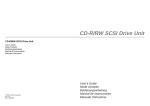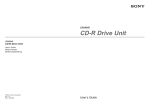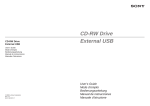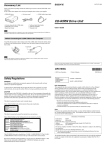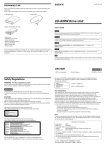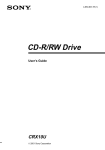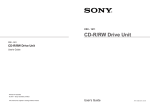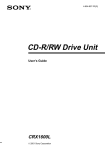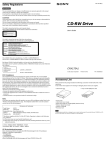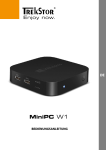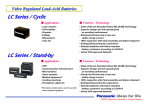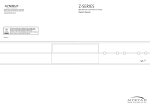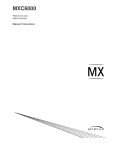Download Sony CDU926S User's Manual
Transcript
CDU926S CD-R Drive Unit CDU926S CD-R Drive Unit User’s Guide Mode d’emploi Bedienungsanleitung User’s Guide ©1997 by Sony Corporation Rev. 1.0 BKC: 98000216 The model and serial numbers are located on the bottom of the drive. Record these numbers in the spaces provided below. Refer to them whenever you call upon your sales representative regarding this product. Model No. __________________ Serial No. ___________________ This unit uses CD-R discs with the following mark. English Owner’s Record This unit uses CD-ROM discs with the following mark. Safety Regulations When you use this unit as a CD player, use compact discs with the following mark. WARNING To prevent fire or shock hazard, do not expose the unit to rain or moisture. To avoid electrical shock, do not open the cabinet. Refer servicing to qualified personnel only. You are cautioned that any changes or modifications not expressly approved in this manual could void your authority to operate this equipment. Caution: As the laser beam in this CDU926S is harmful to the eyes, do not attempt to disassemble the cabinet. Refer servicing to qualified personnel only. The use of optical instruments with this product will increase eye hazard. The use of controls or adjustments or performance of procedures other than those specified herein may result in hazardous radiation. DANGER INVISIBLE LASER RADIATION WHEN OPEN. AVIOD DIRECT EXPOSIRE TOP BEAM VORSICHT This label is located on the drive unit’s internal chassis. UNSICHTBARE LASERSTRAHLUNG. WENN ABDECKUNG GEOFFNET NICHT DEMSTRAHL AUSSETZEN. INVISIBLE LASER RADIATION WHEN OPEN. AVOID DIRECT EXPOSURE TO BEAM. RADIATIONS INVISIBLES DU LASER EN CAS D'OUVERTURE. EVITER TOUTE EXPOSITION DIRECTE AU FAISCEAU. VORSICHT UNSICHTBARE LASERSTRAHLUNG, WENN ABDECKUNG GEÖFFNET. NICHT DEM STRAHL AUSSET ZEN. ADVARSEL USYNLIG LASERSTRÅLING VED ÅBNING. UNDGÅ UDS/ETTELSE FOR STRÅLING. DANGER DANGER Note: This equipment has been tested and found to comply with the limits for a Class B digital device, pursuant to Part 15 of the FCC Rules. These limits are designed to provide reasonable protection against harmful interference in a residential installation. This equipment generates, uses, and can radiate radio frequency energy and, if not installed and used in accordance with the instructions, may cause harmful interference to radio communications. However, there is no guarantee that interference will not occur in a particular installation. If this equipment does cause harmful interference to radio or television reception, which can be determined by turning the equipment off and on, the user is encouraged to try to correct the interference by one or more of the following measures: ● Reorient or relocate the receiving antenna. ● Increase the separation between the equipment and receiver. ● Connect the equipment into an outlet on a circuit different from that to which the receiver is connected. ● Consult the dealer or an experienced radio/TV technician for help. ADVARSEL USYNLIG LASERSTRÅLING NÅR DEKSEL ÅPNES. UNNGÅ EKSPONERING FOR STRÅLEN. VARNING OSYNLIG LASERSTRÅLING NÅR DENNA DEL AR ÖPPNAD. STRÅLEN ÄR FARLIG. VAROI NÄKYMÄTÖN AVATTAESSA OLET ALTTINA LASERSÄTEILYLLE. ÄLÄ KATSO SÄTEESEN. CLASS 1 LASER PRODUCT LASER KLASSE 1 PRODUKT This CD-R drive unit is classified as a CLASS 1 LASER PRODUCT. The CLASS 1 LASER PRODUCT label is located at the bottom of the enclosure. This label is located on the bottom of the drive unit enclosure. 2 3 Contents Introduction Introduction 5 The CDU926S is a drive unit for CD-R discs, which stores a maximum of 650 Mbytes of digital data. Location and Function of Parts and Controls 6 The drive unit has the following features: Front Panel .............................................................................................................6 Rear Panel .............................................................................................................7 ● ● Precautions 8 ● Example of System Setup 8 Installing the Drive Unit into the Computer 9 Getting Started .......................................................................................................9 Setting the Jumpers ...............................................................................................9 Opening the Computer .........................................................................................11 Connecting the Drive............................................................................................12 Mounting the Drive ...............................................................................................13 Host Adapter Installation ......................................................................................15 Closing the Computer...........................................................................................16 ● ● ● ● ● ● ● ● Installing the Software Driver 17 ● ● ● Using Discs and Caddies 18 ● Loading a Caddy with a Disc ...............................................................................18 Storing Discs and Caddies ...................................................................................20 Care of Discs........................................................................................................20 Operating the Drive 4 ● 21 Starting Up ...........................................................................................................21 Ejecting a Caddy ..................................................................................................22 Specifications ● Reads and writes data in both CD-ROM and CD-ROM XA standard formats. Reads and writes data in CD-BRIDGE format which includes PHOTO-CD. Reads standard CD-DA (“Red Book”) encoded discs, and reads and writes CD-R discs conforming to “Orange Book Part II.” Supports the following write modes: Track at once, Variable packet, Fixed packet and Multisession. Outputs the audio as 16-bit digital data over the SCSI interface. Supports read and write operation at both standard speed and double speed, and read-only operation at sixfold speed. Supports real time error correction at all speeds. 5 1/4 inch half-height drive form factor. SCSI bus interface embedded. (Based on SCSI-2) 512 kB buffer memory. Capable of audio CD playback provided with audio line output and headphones jack. Fast access time assures high-speed reading and writing operations. CD caddy for disc protection. Power loading and power eject. Automatic locking of the optical pick-up when the caddy is ejected. This ensures safety during transport. Emergency eject function which allows the caddy to be ejected manually. Capable of real time layered error correction. Employs a casing with an airtight frame. ■ Software requirement Install the appropriate application software before using this unit. 24 Introduction 5 Location and Function of Parts and Controls Front Panel Rear Panel GND GND CD Caddy 1 Jumper block for SCSI bus Specify assignment of the SCSI bus. 1 Caddy insertion slot Accepts a caddy loaded with a CD-ROM or CD-R disc. 2 Emergency eject hole Insert a fine rod into this hole to eject a caddy manually in emergencies. 3 Eject button Ejects the caddy from the drive unit. 4 Busy indicator This indicator shows the unit’s status in various phases of operation. ● Seek, read and write: Flashes amber ● Error: Lights up amber and stays lit When the power is turned on, the indicator lights up green. 5 Volume control Controls the volume of the analog audio output provided via a headphones jack. 6 Headphones jack Provides two channel analog audio output. 6 Location and Function of Parts and Controls 2 Terminators The terminator resistors are inserted into the sockets. Remove the resistors when the SCSI bus is to be terminated externally. Note: Some models are shipped without terminators. When installing the terminators, orient them so that the GND pin (the end marked with a dot) is toward the right side of the socket. 3 Power-in connector Connect to the power supply of the host computer. 4 SCSI bus interface connector Connect to a SCSI host adapter using a connecting cable. 5 Audio output connector Outputs analog audio signals. See page 13 for detail. 6 Frame ground tab Connect to one of the host computer’s ground cables when the drive frame is not in direct contact with the computer. Location and Function of Parts and Controls 7 Precautions ■ Installation Avoid placing the drive in a location subject to: – high humidity – high temperature – excessive dust – mechanical vibration – direct sunlight. Use the drive in a horizontal or vertical position. Do not use it in a tilted position. ● ■ Operation Installing the Drive Unit into the Computer As you go through this section, you may wish to refer to your computer’s manual for a more detailed description of how to install internal drives. Getting Started ● ● ● ● Do not move the drive during operation. This may cause it to malfunction during reading or writing. Avoid exposing the drive to sudden changes in temperature as condensation may form on the lens inside the drive as a result. Should the surrounding temperature suddenly rise while the drive is on, wait at least one hour before you turn off the power. Operating the drive immediately after a sudden increase in temperature, may result in a malfunction during reading or writing. ● Setting the Jumpers Set the jumpers on the rear panel of the drive unit in accordance with the configuration of your computer system. The jumpers are preset, as illustrated below, at the factory. ■ Transportation ● Prepare the necessary parts and tools that have not been supplied: – Screwdriver – four screws 3 mm in diameter (Screws must not extend more than 4.0 mm into the side panels or the bottom plate.) – two mounting rails if your computer has mounting tracks. Unplug the computer and disconnect the cables attached to the back for your own safety. Do not turn on the power of the computer before completing the entire installation process. Keep the original packing materials for future transport of the drive. Remove the caddy before moving the drive and, if you take the drive out of the computer, repack the drive as you received it. DEVICE TYPE PREVENT/ ALLOW ID SELECT 0 1 2 TEST MODE KEY = Pin removed Example of System Setup To use the CD-R device, the following components are required: ● Computer (IBM-PC/AT* compatible) ● SCSI-Host adapter ● SCSI-Interface cable (50 to 50 pin flat cable) ● Software (Device driver, utilities) Terminators OR ECT 2 01 DR L GN OUT IO AUD - 10% 12V+ ND - % G UT 5V+5 C INP D C RFA INTE NN E CO W ODE T M ALLO TES VENT/ PREELECT PE ID S ICE TY DEV D F.GN * IBM-PC/AT is a registered trademark of International Business Machines Corporation. 8 Precautions/Example of System Setup Installing the Drive Unit into the Computer 9 Remove the jumper to set to OFF, and install the jumper to set to ON. The recommended jumper is AMP* Shunts (14227-1), JAE** Short Socket (PS-2SH4-1) or equivalent. The following table shows the function of each jumper. Jumper DEVICE TYPE ID SELECT Function The setting of this jumper determines whether the SCSI device type code in the inquiry data is WO or CD-ROM. ON: WORM OFF: CD-ROM Assign the drive unit’s ID number by setting these jumpers to ON or OFF. Do not assign the same number as one used for other SCSI device. ID number 0 1 2 3 4 5 6 7 KEY PREVENT/ ALLOW TEST MODE Opening the Computer 1 If your computer has its rear side covered by a plastic panel attached with plastic hook pad, pull it off. 2 Remove the cover mounting screws. 3 Remove the cover of the computer. Jumper settings 0 1 2 OFF OFF OFF ON OFF OFF OFF ON OFF ON ON OFF OFF OFF ON ON OFF ON OFF ON ON ON ON ON Used to prevent the SCSI bus interface connector from being plugged in upside down. ON: Allows insert and removal of a CD caddy with the eject button and the eject command. OFF: Prevents insert and removal of a CD caddy with the eject button or an eject command. ON: Enables test mode. OFF: Enables normal operation. Factory settings Notes: ● The upper row of pins (without KEY position) is ground. ● ID SELECT, PREVENT/ALLOW, and TEST MODE are recognized when the power supply is turned on or SCSI bus is reset. ● TEST MODE is used exclusively for the factory testing. Do not set TEST MODE to ON. Doing so may cause an unexpected result. * AMP is a registered trademark of AMP, Inc. ** JAE is a registered trademark of Japan Aviation Electronics Industry, Ltd. 10 Installing the Drive Unit into the Computer Installing the Drive Unit into the Computer 11 ■ Audio output connector Connecting the Drive Attach one end of the flat cable (SCSI cable) to the connector on the rear of the CDR drive. The audio output connector recommended is Molex 5159PBT contacts and 5051-04 housing or 5103 PBT contacts and 5102-04 housing. Pin assignment Interface Connector Sony CDU926S Drive Unit Audio Out Connector Power Supply Connector - 10% 12V+ TOR NEC CE RFA CON ND - % G UT 5V+5 C INP Left signal D INTE 2 01 DR L GN OUT IO AUD W ODE T M ALLO TES VENT/ PREELECT PE ID S ICE TY DEV Right signal GND GND Red Edge D F.GN Flat Cable Mounting the Drive Audio Cable 2 01 DR L GN OUT IO AUD ODE TM TES VENT/A PREELECT P ID S ICE TY V E D 1 Route the flat cable and audio cable through the drive bay from the front of the computer and insert the CD-R drive into the bay as shown. Secure the CD-R drive to the frame by using the prepared screws. Red Wire ND F.G Note The red edge of the flat cable should be positioned next to the power supply connector. It is important that this cable be connected firmly and correctly. - % +10 R 12V GND UT -5% INP 5V+ DC TO EC NN CE CO FA ER INT 01 DLT OU R GN IO AUD Interface Card CD-R Drive 2 DELLOW T MOT/A TES VEN PRESELECT ID ITY PAR ND F.G Mounting Screws Flat Cable Flat Cable If your computer has a Sound Card, connect the audio cable (not supplied) to the AUDIO OUT connector at the rear of the CD-R drive. Sound Card CD-R Drive Audio Cable 12 Installing the Drive Unit into the Computer Audio Cable Note If you cannot secure the CD-R drive to the drive bay, you may need to install slide rails (not included) to the CD-R drive. Refer to your computer user’s guide for additional information. Installing the Drive Unit into the Computer 13 2 Locate an available power supply cable inside your computer and connect it to the power supply connector on the rear of the CD-R drive as shown. Power Supply Connector 5V +- 5% GND 12V +- 10% DC INPUT Host Adapter Installation Connect the free end of the flat cable to the existing SCSI host adapter card and install the host adapter in the computer by inserting it securely in a system expansion slot. Refer to the operating instructions of the host adapter for complete instructions on its installation and the assignment of its switches. 1 49 OR ECT 2 + 5% 5V - DC +- 10% UT Red Edge INP 50 FAC R INTE NN E CO 12V GND ODELLOW TM TES VENT/A PREELECT ID S ITY PAR Power Supply Cable Caution: Improper connection may damage the drive and void the warranty. ■ Frame ground When normally installed, the drive unit is not in contact with the host computer directly and should be grounded. Connect the frame ground tab to one of the host computer’s ground cables. Notes ● The red edge of the flat cable must be closest to pin number 1 of the interface card connector. ● The following illustration is a sample system configuration of the Sony CDU926S CD-R drive installation with a SCSI card. Sony CDU926S Drive Frame ground tab Audio Cable L GND R AUDIO OUT F.GND 012 Power Supply Cable INTERFACE CONNECTOR 5V±5% GND 12V±10% TEST MODE PREVENT/ALLOW ID SELECT DEVICE TYPE DC INPUT SCSI Cable (Not included) 49 50 Frame ground cable The frame ground cable recommended has a AMP 1-480435-0 housing and 170203-2 or 60711-1 contacts. 14 Installing the Drive Unit into the Computer Sound Card (Not included) Red Edge 1 2 SCSI Card (Not included) Speakers (Not included) Installing the Drive Unit into the Computer 15 Installing the Software Driver Termination ● If the CD-R drive is connected at the end of the SCSI chain, keep the drive terminator mounted at the drive. ● If the CD-R drive isn’t the last device at the SCSI bus, remove the termination from the CD-R drive and make sure that the last device at the SCSI bus has a proper termination installed. ● Be aware that the SCSI bus needs to be terminated at each end of the SCSI bus cable. MSCDEX and the device driver for an ordinary SCSI CD-ROM drive can be used when using the CDU926S as a SCSI CD-ROM drive. Use the device driver for a CD-R drive when using the CDU926S as a recordable drive. Be sure to install the device driver before operating the drive. Refer to the manual supplied with the host adapter for instructions. Closing the Computer 1 Replace the cover on the computer, being careful to reinstall all screws that were removed. 2 Replace the AC power cord and turn on your computer. 16 Installing the Drive Unit into the Computer Installing the Software Driver 17 Using Discs and Caddies Loading a Caddy with a Disc 3 Close the lid firmly. 1 To open the caddy lid, press the tabs on the both sides of the caddy at the end opposite to the shutter. Important: Do not drop the disc or the caddy. ● The caddy is designed so that its shutter automatically opens when it is inserted into the drive unit. Do not open the shutter manually and touch the disc. ● Data cannot be recorded if the recording surface is contaminated. ● 2 Set a disc, with its label upward, in the caddy. Be careful not to touch the recording surface when setting a CD-R disc in the caddy. Data cannot be recorded if the recording surface is contaminated. ● 18 Using Discs and Caddies The caddy is precisely adjusted at the factory. Do not disassemble it. Using Discs and Caddies 19 Operating the Drive Make sure that the application software is installed in the host computer before using the drive. Storing Discs and Caddies ● ● Remove the caddy from the drive unit before moving the drive. Do not store the disc and caddy in a location subject to: – high humidity – high temperature – excessive dust – direct sunlight Starting Up 1 Turn on the power supply. 2 Insert the caddy into the drive slot with the disc’s label facing up, and push it partially into the drive until the automatic loading mechanism pulls the caddy in. Care of Discs ● ● ● Hold the disc by its edge. Do not touch the surface. Wipe the CD-ROM disc with the optional CD cleaner to clean it. Do not wipe a CD-R disc with a cleaner before recording data. To avoid scratching the recording surface, blow away dust using an air blower. Important: When inserting the caddy, let the automatic loading mechanism pull it into the drive by itself. Do not hold onto the caddy or attempt to overpower the loading mechanism. The drive begins reading the Table of Contents (TOC) data. The busy indicator lights amber while the TOC data is being read. When the busy indicator changes to green, the drive is ready to receive commands, and data may be retrieved from the disc. After loading the CD-R disc, it takes a moment for the drive to become ready while the Program Memory Area is read. From here on, follow the instructions provided with the application software. Notes: The drive unit does not allow a caddy to be inserted if: – PREVENT/ALLOW of the jumper block is set to OFF. – the host computer is set to the PREVENT mode by the software. ● The busy indicator keeps on lighting amber if: – the disc is not properly inserted. – a malfunction occurs. ● 20 Using Discs and Caddies Operating the Drive 21 In such a case, eject the caddy and re-insert it properly. If the busy indicator remains lit amber, consult your dealer or qualified service personnel. The busy indicator also lights amber during audio play. However, this is not a malfunction. Ejecting a Caddy 1 Turn on the power supply. ■ Ejecting a caddy manually in an emergency In the event of electrical or mechanical failure of the drive unit, a manual emergency eject is provided to allow removal of the caddy from the drive unit. 1 Turn off the power of your computer. 2 Insert a pointed object, such as a paper clip, into the emergency eject hole, and push with hand. (Typical required force is 46 N [4.7 kg]) 2 Press the eject button on the drive unit. atat least 35 mm least Notes: ● The eject button does not work if it is disabled by the software. ● To eject a caddy when the eject button is disabled by the software: – Make sure that the jumper block’s PREVENT/ALLOW is set to ON. – Turn the power of your computer off, and turn it on again. (Or reset the SCSI bus using a software command.) 22 Operating the Drive 35 mm After removing the caddy from the drive unit, consult your dealer or qualified service personnel. Operating the Drive 23 Specifications ■ General ■ Drive performance Host interface Read Function Acceptable discs: Write Function Applied Format: Writing Method: Cache memory (R/W) Disc diameter: Write/Read Speed Write: Read: SCSI-2, single ended, 50 pin CD-ROM Mode-1 data discs CD-ROM Mode-2 data discs CD-ROM XA discs CD-Audio discs Audio-combined CD-ROM discs (includes CD-EXTRA) CD-I discs CD-I Ready Discs CD Bridge discs CD-R discs (Conforming to “Orange Book Part II”) CD-ROM Mode-1 CD-ROM Mode-2 CD-ROM XA CD-Audio Audio-combined CD-ROM (includes CD-EXTRA) CD-I CD Bridge Track at once Variable packet writing (Packet size: max. 512 kByte) Fixed packet writing (Packet size: max. 512 kByte) Multi-session 512 kByte 12 cm 1X, 2X 1X, 2X, 6X Data transfer rate Sustained rate (Mode 1): 150 kbytes/s (1X) 300 kbytes/s (2X) 900 kbytes/s (6X) SCSI Interface Burst rate: 5 Mbytes/s (asynchronous) 10 Mbytes/s (synchronous) Access time Full stroke: 350 ms (typical/6X) Average: 220 ms (typical/6X) ■ Reliability MTBF: 100,000 POH (with 25% duty cycle) Output level Line out: Headphone: 0.7 V at 47 kΩ 0.55 V at 32 Ω ■ Audio ■ Environmental conditions Relative humidity Temperature Operating Transportation Storage Temperature and humidity gradients Vibration Operating Non-operating Transportation Shock Operating Non-operating Transportation 24 Specifications 10% to 90% (no condensation) 5°C to 45°C (41°F to 113°F) –40°C to 60°C (–40°F to 140°F) (within 72 hours) –30°C to 50°C (–22°F to 122°F) (within 6 months) 10°C/hour, 10%/hour Read: 1.96 m/s2 (0.2 G peak) at 5 Hz to 300 Hz (sweep) Write: 0.98 m/s2 (0.1 G peak) at 5 Hz to 300 Hz (sweep) 19.6 m/s2 (2 G peak) at 7 Hz to 300 Hz 1.44 m2/s3-Hz (0.015 G2/Hz) at 5 Hz to 50 Hz Read: 49 m/s2 (5 G) at 11 ms half sine wave (includes 5 retries) Write: 4.9 m/s2 (0.5 G) at 11 ms half sine wave 490 m/s2 (50 G) at 11 ms half sine wave 76 cm drop (with standard individual package) Specifications 25 ■ Dimensions and weight Dimensions Mass ■ Dimension diagram 146.05 x 41.4 x 203.2 mm (w/h/d) (5 3/4 x 1 5/8 x 8 inches) 1.04 kg 41.4 146 21.9 139.7 ■ Power requirement Seeking, spin up & write (50% duty cycle) +5 Vdc +12 Vdc < 900 mA (Max) < 600 mA (Max) 760 mA (Typ) < 1000 mA (Max) 670 mA (Typ) < 1400 mA (Max) 79.25 +5 Vdc +12 Vdc 47.5 Current Hold track state +5 V ±5% DC and +12 V DC ±10% +5 V: 0.05 Vp-p +12 V: 0.1 Vp-p 203 Voltage Ripple 10 ■ Connectors 148.5 4-M3 Mounting screws CD Caddy ■ Laser Type Wave length Output power Beam divergence Semiconductor laser GaAlAs 775 ~ 790 nm (at 25°C) 2.5 mW (Read) 35 mW (Write) 60 degree ■ Optional accessories Additional caddies: Specifications 0.8 0.8 42.5 OPA-2000 OPA-1011/2 OPA-600 Design and specifications are subject to change without notice. 26 4-M3 Mounting screws 5 Molex 53450-5411 or equivalent Molex 50460-4A or equivalent 42.5 Power-in connector Audio connectors Unit: mm Important Screws must not extend more than 4.0 mm into the side panels or the bottom plate. Specifications 27














